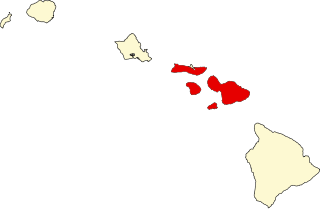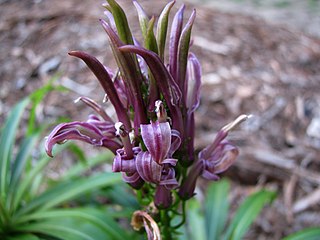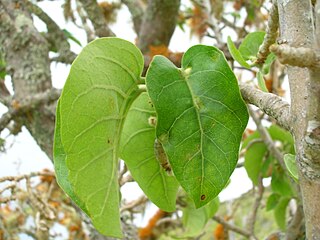Related Research Articles

The nene, also known as the nēnē or the Hawaiian goose, is a species of bird endemic to the Hawaiian Islands. The nene is exclusively found in the wild on the islands of Oahu, Maui, Kauaʻi, Molokai, and Hawaiʻi. In 1957, it was designated as the official state bird of the state of Hawaiʻi.
Aiea or ʻAiea may refer to:
Located about 2300 miles (3680 km) from the nearest continental shore, the Hawaiian Islands are the most isolated group of islands on the planet. The plant and animal life of the Hawaiian archipelago is the result of early, very infrequent colonizations of arriving species and the slow evolution of those species—in isolation from the rest of the world's flora and fauna—over a period of at least 5 million years. As a consequence, Hawai'i is home to a large number of endemic species. The radiation of species described by Charles Darwin in the Galapagos Islands which was critical to the formulation of his theory of evolution is far exceeded in the more isolated Hawaiian Islands.

Maui Nui is a modern geologists' name given to a prehistoric Hawaiian island and the corresponding modern biogeographic region. Maui Nui is composed of four modern islands: Maui, Molokaʻi, Lānaʻi, and Kahoʻolawe. Administratively, the four modern islands comprise Maui County. Long after the breakup of Maui Nui, the four modern islands retained plant and animal life similar to each other. Thus, Maui Nui is not only a prehistoric island but also a modern biogeographic region.

The moa-nalo are a group of extinct aberrant, goose-like ducks that lived on the larger Hawaiian Islands, except Hawaiʻi itself, in the Pacific. They were the major herbivores on most of these islands until they became extinct after human settlement.
The ʻāmaui or Oahu thrush was a subspecies of the olomaʻo endemic to the island of Oahu. It was the first member of its genus to become extinct, c. 1850. Some taxonomic authorities consider it a distinct species, but the International Ornithological Congress presently classifies it as a subspecies of M. lanaiensis.

This is a list of properties and historic districts in Hawaii listed on the National Register of Historic Places. More than 340 listings appear on all but one of Hawaii's main islands and the Northwestern Islands, and in all of its five counties. Included are houses, schools, archeological sites, ships, shipwrecks and various other types of listings. These properties and districts are listed by island, beginning at the northwestern end of the chain.

The Hawaiian lobelioids are a group of flowering plants in the bellflower family, Campanulaceae, subfamily Lobelioideae, all of which are endemic to the Hawaiian Islands. This is the largest plant radiation in the Hawaiian Islands, and indeed the largest on any island archipelago, with over 125 species. The six genera involved can be broadly separated based on growth habit: Clermontia are typically branched shrubs or small trees, up to 7 metres (23 ft) tall, with fleshy fruits; Cyanea and Delissea are typically unbranched or branching only at the base, with a cluster of relatively broad leaves at the apex and fleshy fruits; Lobelia and Trematolobelia have long thin leaves down a single, non-woody stem and capsular fruits with wind-dispersed seeds; and the peculiar Brighamia have a short, thick stem with a dense cluster of broad leaves, elongate white flowers, and capsular fruits. The relationships among the genera and sections remains unsettled as of April 2022.

Havaika is a genus of the spider family Salticidae. The genera Habronattus and Pellenes are closely related. All then known species were split from the genus Sandalodes.

Wikstroemia is a genus of 55-70 species of flowering shrubs and small trees in the mezereon family, Thymelaeaceae. Hawaiian species are known by the common name ‘ākia.

The olomaʻo is a small, dark solitaire endemic to Maui, Lānaʻi and Molokaʻi in the Hawaiian Islands. It is listed as Critically Endangered or possibly extinct.

Nothocestrum is a genus of flowering plants in the nightshade family, Solanaceae. It contains four species of large shrubs or small trees that are endemic to Hawaii, where they are known as ʻaiea.

Stenogyne is a genus of flowering plants in the mint family first described in 1830. The entire genus is endemic to Hawaii.
- Stenogyne strangulationA.Gray - narrow leaf stenography
- Stenogyne bifidaHillebr. - two cleft stenography - Molokai
- Stenogyne methodicalnessA.Gray - bog stenography - Big Island
- Stenogyne cosmicallySherff - Maui
- Stenogyne campanulataWeller & Sakai - Kala Valley stenography - Kauai
- †Stenogyne incinerateHillebr - Maui but extinct
- Stenogyne cranwelliaeSherff - Big Island
- †Stenogyne haliakalaeWawra - Maui but extinct
- Stenogyne kaalaeWawra - Oahu
- Stenogyne kamehamehaeWawra - Molokai, Maui
- Stenogyne kanehoanaO.Deg. & Sherff - Oahu stenography - Oahu
- Stenogyne kauaulaensisK.R.Wood & H.Oppenh. - Maui
- Stenogyne kealiaeWawra - Kauai
- Stenogyne macranthaBenth. - Big Island
- Stenogyne microphyllaBenth. - Maui, Big Island
- †Stenogyne oxygonaO.Deg. & Sherff - Big Island but extinct
- Stenogyne purpureaH.Mann - Kauai
- Stenogyne rotundifoliaA.Gray - pua'ainaka - Maui
- Stenogyne rugosaBenth. - ma'ohi'ohi - Maui, Big Island
- Stenogyne scrophularioidesBenth. - mohihi - Big Island
- Stenogyne sessilisBenth. - Lanai, Maui, Big Island
- †Stenogyne viridisHillebr. - Maui but extinct
References
- ↑ BirdLife International (2018). "Francolinus francolinus". IUCN Red List of Threatened Species . 2018: e.T22678719A131903818. doi: 10.2305/IUCN.UK.2018-2.RLTS.T22678719A131903818.en . Retrieved 18 November 2021.